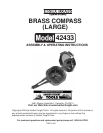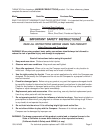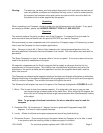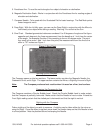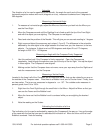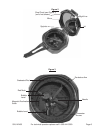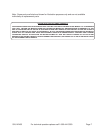
SKU 42433 For technical questions please call 1-800-444-3353. Page 3
Warning: The warnings, cautions, and instructions discussed in this instruction manual cannot
cover all possible conditions and situations that may occur. It must be understood by
the operator that common sense and caution are factors which cannot be built into
this product, but must be supplied by the operator.
Unpacking
When unpacking your Compass, check to make sure the following parts are included. If any parts
are missing or broken, please call HARBOR FREIGHT TOOLS at 1-800-444-3353.
Operation
This manual explains the parts and basic use of the Compass. It is important that you read the
entire manual to become familiar with the product BEFORE you use the Compass.
We recommend you use a separate book (not included) on Compass usage or Orienteering, to learn
how to use the Compass for more complex applications.
Note: We want to thank Mr. J. Calvert (http://www.du.edu/~jcalvert/personal/pershom.htm) for
providing additional information that was included in this manual. This information was used with his
permission.
The Brass Compass is a type of compass called a “mirror compass.” It has many uses and can be
used for the practical measurement of angles.
All magnetic compasses use the Earth’s magnetic field to supply a reference direction for the
measurement of horizontal angles. This direction has a fundamental significance only when the
directions on the earth’s surface are to be specified, and then the magnetic declination must be
taken into account.
This Compass can determine the magnetic heading of an object and its angle of elevation or declination.
Magnetic declination is the difference between the true geographic north (north pole) and the magnetic
north (in northern Canada). This variation fluctuates throughout the world.
The following list will explain the uses of the parts of the Compass highlighted in FIGURES 2 and 3.
1. Mirror -This is used to view the compass capsule. It is designed in this way so you can see
your target and get a measurement at the same time. When hinged at 45 degrees, the
mirror can aid in finding the altitude angle measurements while simultaneously looking
at the object.
Note: To get proper directional orientation, the mirror should be used to read the
compass.
2. Graduated Dial - By increments of 1 degree, the dial is graduated 0 degrees through 360
degrees. It is used to read compass bearings.
3. Levels - Allows for altitude and angles measurement as well as plumb leveling.
4. Clinometer Arrows - The arrow pointing to the ground when the Compass is on its side, is used
in conjunction with the orienting circles to measure angle of inclination.



